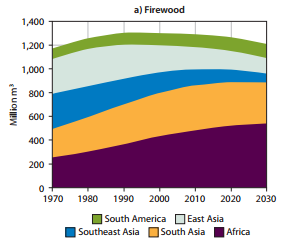Wood fuel, in its many forms (i.e. charcoal, fuel wood or firewood, wood pellets, and other forms of biomass energy) is a primary energy source of households (Tobin, 2011; Remedio, 2002) including, to some extent bakeries and municipal slaughterhouses. Wood fuel, as defined in PD 1559, would fall under the definition of forest products, to wit: “Forest products means timber, pulpwood, firewood, bark, tree top, resin, gum, wood, oil, honey, beeswax, nipa, rattan, or other forest growth such as grass, shrub, and flowering plant, the associated water, fish, game scenic, historical, recreational and geologic resources in forest lands.” According to Krummer, 1992 and Lasco et al. 2001, fuel wood gathering and charcoal making constitute two of the most rampant activities in the Philippines. On a regional scale, about 1.4 billion cubic meters of firewood are used each year of which 40 million metric tons of charcoal are produced (Hofstad, Kohlin, and Namaalwa 2009; Tobin 2011). As shown in the figures[1] below, the projected usage of firewood and charcoal in different parts of the world is generally increasing, especially in Southeast Asia. Projections show that charcoal use will increase tremendously for at least the next 15 years until 2030.


A study conducted in 1992 in Cebu, Philippines, showed that fuelwood and charcoal ranked highly as primary and secondary fuel source for household cooking, respectively. The same study was done a decade later and showed similar results for charcoal but an increased ranking (i.e. second) for fuelwood (Remedio and Bensel 2002; Remedio 2002). These studies point to the urgent need for a nationwide study on wood fuel in the face of continued forest degradation focusing on charcoal and fuelwood. There are no established wood fuel plantations in the Philippines. Chances are, wood fuel is sourced from the natural forest. Section 78 of the Revised Forestry Code of the Philippines (PD 705) strictly prohibits the collection, gathering, processing and trading wood fuels from forest lands. Furthermore, it is clearly stated in PD 705, PD 1559 and as amended in EO 277 that cutting, gathering and/or collecting timber and other forest products without legal documents as requirements under existing forest laws and regulations shall be penalized if said products are extracted from any forest lands, alienable and disposable lands or from private lands. Needless to say, a license to cut, gather and/or collect should be secured. In general, the Department of Environment and Natural Resources (DENR) has issued administrative orders that seemingly promote the harvesting of wood fuels. These are:
- Ministry Administrative Order No. 4, 19 January 1987 – lifts the restriction in the harvesting, transporting and sale of fuelwood, pulpwood or timber produced from ipil-ipil (Leucaena spp.) and falcata (Albizia falcataria) planted in private lands.
- DENR Administrative Order No. 86, 4 October 1988 – prescribes the rules and the deregulation of tree harvesting, transporting and
sale of fuelwood, pulpwood or timber planted in private lands. - DENR Administrative Order No. 27. Series of 1989 – bans the exportation of fuelwood to assist the local enterprises using wood to generate energy.
- DENR Administrative Order No. 26, 22 February 1990 – amends DENR Administrative Order No. 86-88 by including all other tree species planted in private lands, except premium hardwood species, in the lifting of restriction in the harvesting, transporting and sale of fuelwood.
- DENR Administrative Order No. 79, 19 September 1990 – amends DENR Administrative Order No. 26, Series of 1990 by excluding Benguet pine (Pinus kesiya) in the list of species whose harvesting, transporting and sale of fuelwood have been lifted. Hence, the cutting, transportation and disposition of Benguet pine within private lands shall be covered by a Private Land Timber Permit (PLTP).
While EO No. 23 has put a stop to the cuttingand harvesting of timber in the natural and residual forests and created the anti-illegal logging task force, the supply of charcoal and fuelwood proliferate in the market. In fact, a popular chicken roast shop openly promotes the use of charcoal. Around the lower slopes of Mount Makiling Forest Reserve ASEAN Heritage Park (MMFR AHP), especially in the resort areas of Pansol, Calamba, there is an active and very
visible market of wood fuel. Sellers are not compelled to show certified sources of wood fuel. To make matters worse, its production, distribution, trade and consumption is not monitored, regulated and managed, if at all.
Therefore, there is a need to impose a chain-of-custody (CoC) certification for producers and traders to ensure that wood fuels are sourced from well-managed forests.
[1] Hofstad, Kohlin, and Namaalwa, 2009
by NCBantayan and MBCLlanza


